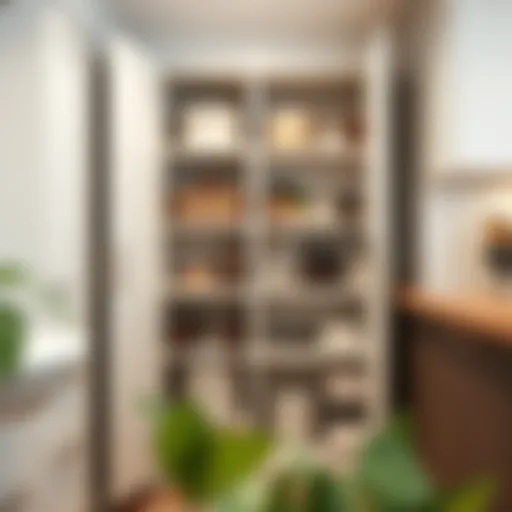Exploring the Dynamics of Glass Stove Top Ovens
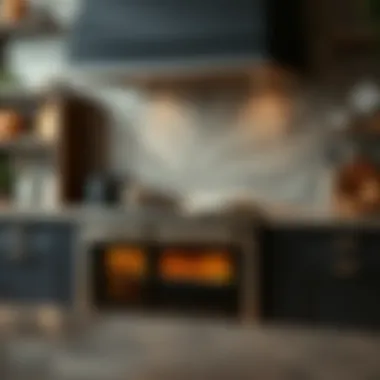

Intro
In recent years, glass stove top ovens have catapulted from being mere kitchen appliances to becoming the focal point of modern kitchens. These sleek, shiny surfaces are not only functional but also contribute to the overall aesthetic appeal of the space. Many homeowners and designers alike are captivated by their ability to combine practicality with elegance, making them a preferred choice when renovating or upgrading a kitchen. As the design landscape evolves, understanding the dynamics of these ovens becomes extremely relevant for anyone involved in kitchen design and functionality.
The aim here is to dissect their design elements, explore their functionality, and to identify the key advantages these ovens bring to the table – or rather, the kitchen countertop. By examining the maintenance required, potential repair techniques, and innovative qualities, we unearth the charm and benefits of glass stove top ovens in modern kitchens.
This is not just a guide; it is a closer look at how these appliances harmonize with a variety of interior design trends while maintaining functionality in culinary arts. We aim to equip interior designers, retailers, and homeowners with knowledge and insights, so they can make informed decisions about the kitchens of today.
Intro to Glass Stove Top Ovens
In a world where ever-changing trends increasingly shape our living spaces, the kitchen remains a pivotal area in every home. Among kitchen appliances, glass stove top ovens have carved out a niche, balancing both functional excellence and aesthetic appeal. Their emergence reflects a growing desire for sleek designs that complement modern cooking techniques.
Definition and Functionality
A glass stove top oven refers to a cooking appliance that incorporates a smooth glass surface, generally ceramic or tempered glass, over heating elements. The glass surface can be hypnotically beautiful, offering a sleek look that most traditional stovetops lack. These ovens usually feature cook zones indicated by lights or markings, giving users clear guidance on where to place their pots and pans.
When it comes to functionality, ease of use is a notable benefit. Their flat surface promotes even heating and an easy-to-clean experience, which can be a godsend for busy cooks. Unlike gas ranges, which may pose more challenges with control and cleanup, glass stove tops provide quicker temperature responses, making them an attractive option for both novice cooks and seasoned chefs.
Historical Overview
The beginnings of glass stove top ovens can be traced back to the late 20th century when electric cooking appliances began gaining popularity. Previous generations preferred gas ranges for their perceived authenticity and robust heat. However, as technology evolved, new materials allowed manufacturers to explore alternatives. Ceramic glass emerged as a durable option, leading to a revolution in design. The introduction of glass cooktops aligned perfectly with modern kitchen aesthetics, piecing together a trend that valued minimalism and elegance.
As these appliances became more common in households, manufacturers also focused on enhancing efficiency. Advances in induction cooking technology showcased its potential to improve energy use while offering precise temperature control. This trend contributed to the evolution of glass stove tops, merging innovative cooking technology with modern design principles.
Design Features
The design features of glass stove top ovens extend beyond mere visual appeal; they play a pivotal role in both functionality and user experience. These elements harmoniously blend style with practicality, making them a popular choice for modern kitchens. By examining material composition, aesthetic appeal, and size configuration, we gain a deeper understanding of how these features meet the needs of homeowners and designers alike.
Material Composition
The foundation of any stove top oven lies in its material. Glass stove tops are primarily made from tempered glass, a durable and heat-resistant material that can withstand high cooking temperatures. This innovation results in a smooth surface that not only looks sleek but also enhances the cooking experience. Unlike traditional metal or ceramic tops, tempered glass offers easy cleanup, resisting stains and burns effectively.
Moreover, the strength of tempered glass allows it to be integrated with other materials, such as stainless steel or ceramic. When combined, these materials can elevate the overall design of the kitchen. Homeowners often appreciate the durability that glass provides, as it significantly reduces the wear and tear typically seen in other materials. By investing in a glass stove top oven, users enjoy both style and durability, ensuring their appliance remains a centerpiece for years to come.
Aesthetic Appeal
Aesthetic appeal is where glass stove top ovens truly shine. They bring a contemporary elegance that can transform a kitchen from a simple cooking space to a culinary showcase. The translucency of glass allows for a lighter feel, making even small kitchens appear more spacious. Homeowners can choose from various finishes and colors that complement their existing decor, providing endless customization options.
In recent years, minimalism has been a significant trend in interior design. Glass stove tops align perfectly with this ethos, often featuring clean lines and smooth surfaces that create a minimalist look. Additionally, some models come with backlit controls, adding a modern touch and enhancing usability. This blend of sophisticated design with practicality makes these ovens appealing not just to homeowners, but also to designers who wish to create functional yet beautiful spaces.
Size and Configuration Options
When it comes to installations, size and configuration play crucial roles. Glass stove top ovens come in various sizes to accommodate different kitchen layouts and cooking styles. Whether you have a compact urban apartment or a sprawling family home, there’s a model that fits seamlessly into your space. Common sizes range from 30 inches to 36 inches wide, catering to both small and large cooking needs.
Furthermore, different configuration options allow customization according to cooking preferences. Some models feature multiple burners of varying sizes, perfect for everything from boiling pasta to sautéing vegetables. Other designs incorporate specialty features like induction heating, which provides rapid, even cooking.
"Selecting the right size and configuration ensures that your glass stove top oven fits beautifully into your kitchen while meeting your culinary needs."
In summary, the design features of glass stove top ovens not only enhance their visual appeal but also cater to practical needs. From durable materials and stylish aesthetics to flexible sizes and configurations, these ovens truly embody what modern cooking appliances should be. By focusing on these elements, designers, retailers, and homeowners can make informed choices that elevate their kitchen experience.
Benefits of Glass Stove Top Ovens
When considering kitchen appliances, glass stove top ovens hold a special place. They not only serve practical purposes but also add a layer of elegance to any culinary space. This section fleshes out the various benefits that these ovens bring, especially as we evolve into more modern kitchens that prioritize both aesthetics and functionality.
Visual Integration in Modern Kitchens
The design of glass stove top ovens speaks volumes. Their sleek and shiny surfaces present a polished look that seamlessly integrates with various kitchen styles. Whether your kitchen is minimalist, rustic, or contemporary, glass ovens can meld in flawlessly owing to their versatile hues and gleaming finishes. It’s like that right pair of shoes that completes an outfit, you know?
Having a central appliance that is as much a statement piece as it is functional is vital in today’s design-conscious world. Features such as glowing touch controls and elegant glass surfaces can wow guests, turning the kitchen into not just a cooking space but a gathering point.
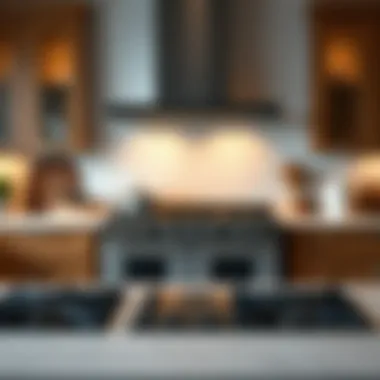

Moreover, different manufacturers provide options that cater to specific themes. For example, some may focus on darker tones to contrast lighter cabinetry, while others may bring in textures to accompany various countertops. This visual flair doesn’t just impress; it also invites creativity in how you arrange and design the rest of the kitchen.
Efficiency and Cooking Performance
Turning to efficiency, glass stove top ovens are a boon for the savvy cook. These appliances heat up quickly, which reduces cooking time significantly. Gone are the days of waiting endlessly for pots to boil. The smooth surface allows even heat distribution, ensuring all parts of the dish receive the necessary warmth.
Some might argue that old-school ranges prove more reliable, yet glass ovens have proven them wrong over the years. Implementing advanced heating technologies, many glass stoves now boast options such as induction cooking, which is not only efficient but safer too. You can cook with precision, adjusting the temperature without any lag—it’s pretty much an instant turnaround.
A few user-friendly features to consider include:
- Overheat Protection: You don’t want burnt dinners. Many models automatically turn off if they sense excessive heat.
- Touch Control Panels: With easy reading displayed on glass, you can adjust settings quickly and efficiently.
Health and Safety Considerations
Health and safety are foundational aspects of any kitchen equipment, and glass stove top ovens often shine here too. One significant merit is the ease of cleaning. Spills don’t get burnt onto the surface as easily as they might on traditional gas ranges. A quick swipe with a damp cloth can remove even the toughest stains, minimizing the risk of food contamination.
Additionally, the cool-to-touch feature on many glass stove tops means that you can prepare your kitchen without burning yourself on hot surfaces. This is especially important in homes with children, where safety is a paramount concern.
Furthermore, these ovens tend to produce less heat in the surrounding environment, making it a more comfortable space to work in, especially during warm months. The added bonus? Less heat means lower energy bills. Who doesn't want that?
"Choosing the right kitchen appliance is not just about cooking; it's about enhancing your lifestyle and ensuring safety while whipping up culinary delights."
Wrapping up, glass stove top ovens bring a multitude of benefits to the table—integrating seamlessly into modern designs, enhancing cooking efficiency, and prioritizing health and safety. These advantages make them a worthy investment for any kitchen, serving not just as appliances but as integral components of a living space.
Market Variations
In a crowded kitchen appliance marketplace, glass stove top ovens stand out not only for their aesthetic appeal but also for their diversity in brands and models. Understanding the variations in this segment is crucial for consumers and designers alike. As the kitchen evolves into a multi-functional space, the choice of a stove top oven goes beyond mere functionality. It intertwines with design, efficiency, and personal cooking preferences. With a myriad of options available, knowing the distinctions among brands and models can significantly enhance the cooking experience.
Different Brands and Models
When it comes to glass stove top ovens, there are several prominent brands that compete for market share. Each of these brands brings its unique flair and specialized features, setting them apart from one another.
For instance, Bosch is often known for integrating cutting-edge technology with sleek designs. Their models typically focus on efficiency and user-friendliness. Then there's Samsung, a brand that combines smart features with robust performance, allowing users to control their ovens through mobile apps.
GE Appliances, on the other hand, combines residential need with commercial-grade performance, catering to home chefs who seek professional quality in their cooking. Likewise, Whirlpool offers dependable options that balance performance with affordability, making them popular in mid-range households.
Each manufacturer provides a different layout, be it built-in or standalone models, and this impacts the installation process and kitchen design.
Comparative Features and Pricing
Comparing the features of each brand reveals significant insights that can guide potential buyers. For example:
- Cooking Technology: Many high-end brands offer induction options where heat is generated directly in the cookware, ensuring energy efficiency. Meanwhile, standard electric models typically distribute heat through coils.
- User Control Interfaces: The ease of use varies. Brands like KitchenAid incorporate advanced touch controls that appeal to tech-savvy users, while models from Maytag tend to stick to more traditional knobs and buttons for simplicity.
- Safety Features: An increasingly important aspect, particularly for families, is safety. Brands such as Frigidaire are focused on enhancing child safety locks and automatic shut-off systems.
When it comes to pricing, the market clearly reflects the features offered. Basic models can be found for around $600, whereas luxury versions with smart technology may reach upwards of $2000 or even more.
Potential buyers should weigh their needs against their budget. If you prioritize high-tech features, investing in a premium brand might be worth the price. However, if you need a reliable oven for everyday cooking, mid-range options can offer great value without breaking the bank.
"The right choice of stove top oven can redefine not just your cooking but your entire kitchen experience. It’s about marrying form and function seamlessly."
As one dives into market variations, it becomes clear that no two models are alike. Recognizing these differences equips homeowners, renters, and design professionals with the knowledge necessary to make informed decisions, ensuring their glass stove top oven complements both their cooking style and aesthetic preferences.
Installation Requirements
When it comes to glass stove top ovens, installation processes play a pivotal role in the functionality and safety of the appliance. An improper installation can lead to performance issues and potential hazards, which makes understanding installation requirements indispensable for homeowners and designers alike. Having a clear idea of what modifications might be necessary can save time and frustration down the line. Moreover, it ensures that the oven fits well within the kitchen's overall design and layout.
Necessary Kitchen Modifications
Before anyone jumps to the installation phase, it’s crucial to have an outline of necessary kitchen modifications. These can vary depending on the design of the stove, the layout of the kitchen, and how the oven will integrate with existing elements. Here are some essential considerations:
- Countertop Compatibility: Glass stove tops typically require a level surface for optimal operation. Countertops with imperfections might need adjustments. Reinforcement or replacement may be required if the countertop isn’t sturdy enough to support the glass adequately.
- Ventilation Requirements: Proper airflow is vital. Some models may require additional ventilation setup, especially if they are designed to handle higher heat outputs. Often, this needs the installation of a range hood or external venting solutions.
- Electrical or Gas Connections: Connecting the stove to a power source or gas line is another thing to consider. If opting for electric, ensure that the kitchen has adequate wiring to manage the load. For gas connections, professional installation is often a wise choice to meet safety regulations.
- Space for Other Appliances: A glass stove top offers visual elegance, but it should harmonize with other appliances, too. The spacing between the oven and wall-mounted cabinets should allow for comfortable cooking and ventilation. Keeping these factors in check adds to a seamless kitchen environment.
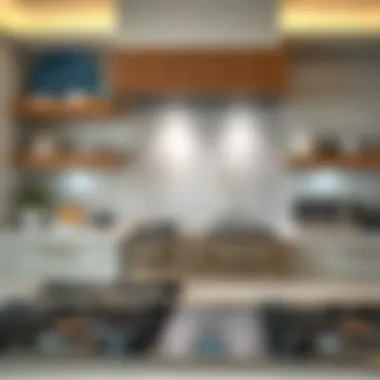

"A well-planned installation not only boosts efficiency but also enhances the kitchen’s overall aesthetic ambiance."
In sum, these modifications are crucial for safety and aesthetics. They provide a well-rounded foundation for the glass stove top oven to function correctly and harmoniously within any kitchen setup.
Professional Installation vs. DIY
When thinking about installing a glass stove top oven, homeowners are often torn between hiring a professional and going the DIY route. There are pros and cons to each approach—let’s break them down further.
Professional Installation
- Expertise and Knowledge: A professional comes equipped with the know-how of the latest models and installation methods. They can address complex plumbing or electrical issues efficiently.
- Warranty Protection: Many manufacturers require that professional installation be conducted for warranty validation, ensuring that any future issues will be covered without hassle.
- Safety Compliance: Professionals are usually well-versed in local building codes and safety standards, which helps to avoid possible fines or hazards in the future.
DIY Installation
- Cost Savings: Undertaking the installation yourself can save money, especially if you possess some handy skills. You pay only for the materials, not for labor.
- Personalized Approach: Doing it yourself offers the flexibility to tailor the installation process as per your preferences—down to the last detail.
- Learning Experience: For some individuals, taking on home projects can yield valuable skills for future endeavors.
Yet, it’s important to weigh these options carefully. While a DIY approach can be fulfilling, one must acknowledge the potential risks of errors, especially when dealing with volatile elements like gas or electrical components. In the end, the decision may hinge on one’s comfort level with home improvement tasks.
Maintenance Guidelines
Maintaining glass stove top ovens is crucial for ensuring their longevity and optimal performance. With the delicate nature of glass surfaces, combined with the heat generated during cooking, taking proper care of these appliances becomes essential. Not only does a well-maintained stove top cook efficiently, but it also adds to the overall aesthetic appeal of a kitchen.
Cleaning Techniques
Regular cleaning is the cornerstone of maintaining a glass stove top. It's imperative to use the right techniques and products to avoid damaging the surface. Here are some effective cleaning methods:
- Routine Wipe Downs: After each use, it’s beneficial to wipe down the surface with a soft cloth to remove any spills or splatters. This prevents the buildup of stains and keeps the stove looking pristine.
- Use of Safe Cleaners: Look for non-abrasive cleaners specifically formulated for glass surfaces. Harsh chemicals or rough scrubbers can scratch the glass, leading to permanent damage.
- Baking Soda Paste: For stubborn stains, a paste of baking soda and water can work wonders. Apply it to the stain, let it sit for a few minutes, then gently scrub with a soft sponge before rinsing.
- Microfiber Cloths: Using a microfiber cloth can help prevent scratching while effectively lifting grime off the surface.
"Regular maintenance not only keeps your glass stove top looking good, but it also enhances safety by minimizing the risk of food contamination due to residue."
Preventive Maintenance Practices
To prolong the life of a glass stove top oven, some preventive measures should be adopted:
- Avoid Heavy Pots and Pans: Heavy cookware can cause cracks or scratches on the glass surface. It’s wise to lift rather than slide pots and pans when repositioning them.
- Temperature Management: Rapid changes in temperature can stress the glass. It's best to avoid placing cold items directly on a hot stove top and vice versa.
- Use of Heat Diffusers: For those who often use heavy cookware, employing a heat diffuser can help distribute the heat more evenly and minimize direct contact with the glass.
- Regular Inspection: It’s prudent to inspect the glass surface for any cracks or chips regularly. Early detection allows for timely repairs or replacement, thus preventing further damage.
- Educating Household Members: Ensure everyone in the household understands how to care for the stove top. Simple practices can lead to a significant reduction in wear and tear.
By incorporating these maintenance guidelines, homeowners can not only enhance the functionality of their glass stove top ovens but also maintain their beauty over time. This contributes to creating a kitchen space that aligns with both aesthetic and practical needs.
Common Issues and Troubleshooting
The functionality and performance of glass stove top ovens can sometimes be less than ideal. Understanding the common issues that may arise and knowing how to troubleshoot them is crucial for both usability and satisfaction. These problems might not only hinder cooking efficiency, but can also impact the longevity of the appliance. Addressing them promptly can save you time, money, and ultimately, frustration.
Identifying Performance Issues
Identifying performance issues is the first step in ensuring your glass stove top oven operates smoothly. Some common signs that something might be amiss include:
- Uneven heating: If certain areas of the glass cooktop do not heat as effectively as others, this could signal problems with the heating elements or the connection to the power source.
- Delayed heating: When your stove takes longer than usual to reach the desired temperature, it might be time for an inspection. This could result from anything from a faulty thermostat to issues with the electrical supply.
- Visible damage: Cracks or scratches on the glass top can lead to further issues. If the glass is compromised, it may not heat properly or could be a safety hazard.
Recognizing these issues early can prevent more significant complications down the road. It's important not to ignore subtle signs that indicate inefficiencies.
Solutions for Common Problems
Once you’ve identified a problem, the next step is applying the right solutions. Here are practical approaches to address typical challenges:
- For uneven heating: Check the burners to ensure they are properly seated. Sometimes, reinstallation can make a difference. If the heating element itself is faulty, replacement may be necessary.
- To combat delayed heating: Start by inspecting the electric connections. Loose wiring can often be the source of sluggish performance. If this doesn't yield results, testing the thermostat with a multimeter may pinpoint the issue.
- Repairing visible damage: If you notice cracks, avoid using the stove until it has been repaired or replaced. A professional can assess whether a simple repair will suffice or if a full replacement is warranted.
"Early detection of problems is key to prolonging the life of your kitchen appliances. Regular checks can save you from an unexpected breakdown."
In addition to these solutions, employing preventive measures can drastically reduce the likelihood of performance issues. Regular cleaning and maintenance, alongside using cookware that is compatible with glass surfaces, will contribute to a more efficient cooking experience. Consider writing down any irregularities you notice and consulting your oven’s manual or a qualified technician to ensure all aspects are taken care of.
By effectively identifying and troubleshooting issues, you'll not only maintain the functionality of your glass stove top oven but can also elevate your overall culinary experience.
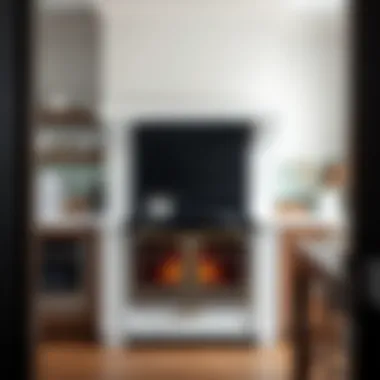

Integrating Glass Stove Top Ovens into Kitchen Design
The integration of glass stove top ovens into contemporary kitchen designs is no small feat; it demands an understanding of both aesthetics and functionality. These ovens serve as a focal point in kitchen layouts, blending visual appeal with practical cooking capabilities. A well-designed kitchen does not merely function well but also reflects the personality and lifestyle of its inhabitants. Selecting the right stove top can elevate the culinary experience, making it enjoyable and efficient. This section explores how to harmonize glass stove tops with other kitchen elements to create a cohesive and sophisticated space.
Coordinating with Kitchen Elements
When incorporating a glass stove top, attention to the surrounding kitchen elements is crucial. The color scheme, cabinetry, and countertop materials all play vital roles in achieving synergy. Here are factors to consider:
- Color and Finish: Glass stove tops are often sleek and modern, so it's important to match them with other high-gloss or matte finishes in the kitchen. A stainless steel appliance can complement a black glass surface, providing a contemporary edge.
- Cabinetry Style: The design of your cabinets should complement the stove. For instance, a minimalist cabinet style paired with a clean glass design emphasizes simplicity and elegance.
- Countertop Materials: Solid surfaces like quartz or granite can enhance the aesthetic appeal of glass stove tops. The reflection from glass can create beautiful contrasts, making the kitchen feel spacious and inviting.
When these elements coordinate, you create a cohesive kitchen environment that invites culinary creativity.
Enhancing Functionality and Style
Glass stove tops not only transform the look of your kitchen but also influence its functionality. Their smooth surface is easier to clean, reducing the hassle often associated with traditional stovetops. However, the right integration goes beyond just cleaning ease:
- Cooking Zone Design: Plan your cooking zones strategically to enhance ease of use. For example, placing utensils and pots close to the stove optimizes workflow, making meal preparations less cumbersome.
- Smart Features: Some modern glass stove tops come equipped with innovative technology, such as touch controls or integrated timers, which enhance functionality. Consider how these features can work within your kitchen layout to improve the overall cooking experience.
- Lighting Considerations: Proper lighting can highlight a glass stove top’s attractiveness. Under-cabinet lighting provides both functional illumination for cooking and a warm ambiance, presenting the kitchen in the best light.
"A well-integrated kitchen is not just a workspace; it’s the heart of the home, inviting everyone to gather and share in the culinary experience."
For more insights on kitchen design, visit resources like Wikipedia or Britannica to enhance your understanding of the evolving trends in kitchen technology and aesthetics.
Future Trends in Kitchen Technology
In the rapidly evolving world of kitchen technology, understanding future trends is paramount for designers, homeowners, and retailers alike. Glass stove top ovens, in particular, are at the forefront of these technological advancements. As the appetite for innovative and efficient cooking solutions grows, so does the focus on integrating cutting-edge features into kitchen appliances. This section will explore specific innovations and sustainability trends that promise to redefine cooking experiences in homes around the globe.
Innovations in Cooking Technology
Modern kitchens are becoming a playground for innovation, with manufacturers striving to incorporate advancements that enhance user experience. One notable trend in kitchen technology is the incorporation of smart features into glass stove top ovens. These features often include:
- Programmable Settings: Users can set precise temperatures and cooking times, streamlining meal preparation.
- Touch Controls: Many new models now come with intuitive touchscreens that allow for easy navigation and adjustments without the hassle of knobs and buttons.
- Connected Appliances: IoT technology enables ovens to connect to smartphones via apps, offering users remote control, real-time monitoring, and alerts for when meals are ready.
For instance, brands like Samsung have introduced smart kitchen environments that sync all devices, ensuring cooks have all the information they need right at their fingertips. This interconnectedness allows for a seamless cooking experience, where tasks can be managed quietly on a phone while some sauce simmers away on the glass stove top.
Moreover, advancements in heat distribution technologies are improving efficiency. Induction cooking, utilizing electromagnetic energy, provides faster heating and cooler surfaces, further enhancing safety in kitchen environments.
"By embracing the smart kitchen revolution, homeowners can transform their cooking experience from mundane to magical, all at the press of a button."
Sustainability in Kitchen Appliances
Sustainability is no longer a mere trend but a necessity in the world of kitchen appliances. As global awareness of environmental issues rises, manufacturers are making strides to produce more energy-efficient and eco-friendly appliances. This shift incorporates several key elements:
- Energy Star Ratings: New models of glass stove top ovens are increasingly designed to meet strict energy-efficiency guidelines, ensuring minimal power consumption while delivering top-tier performance.
- Sustainable Materials: Appliance manufacturers are experimenting with and utilizing recycled materials in production. This move not only reduces waste but also appeals to environmentally conscious consumers.
- Longer Lifespans and Repairability: The focus is shifting from short-lived products to those that are designed for durability and easy repair, thus reducing landfill waste and promoting sustainability.
A prime example can be found in the offerings from Whirlpool, which emphasizes the use of sustainable materials in their glass stove tops while incorporating energy-efficient designs. These advancements not only benefit the planet but can also lead to cost savings for homeowners in the long run.
Finale
In the realm of modern kitchens, the glass stove top oven stands out as a remarkable combination of beauty and functionality. Understanding the significant elements surrounding these appliances is essential for designers, homeowners, and anyone involved in kitchen planning.
Summarizing Key Points
The discussion has traversed various engaging aspects of glass stove top ovens:
- Definition and Functionality: We explored what constitutes a glass stove top oven and how it operates, emphasizing its dual role in cooking and enhancing kitchen aesthetics.
- Benefits: The efficiency and clean lines of these ovens not only appeal visually but also promise safer cooking environments.
- Market Variations: Recognizing the different brands available assists consumers in making informed choices, catering to diverse budgets and tastes.
- Installation and Maintenance: Guidelines and insights on installation requirements ensure that users can achieve optimal performance and longevity from their appliances.
- Trends: Innovations, especially in sustainability, reflect an industry that is progressing towards more environmentally friendly solutions.
By synthesizing these points, it becomes clear that glass stove top ovens are not merely appliances but integral components of contemporary culinary experiences, marrying technology with style.
Final Thoughts on Glass Stove Top Ovens
As this guide illustrates, careful consideration of design, performance, and maintenance can significantly enhance one’s kitchen experience. By investing in a glass stove top oven, homeowners and designers alike embrace a blend of elegance and practicality that can elevate any kitchen space to new heights. Buying such an appliance is not merely a transaction but an entry into a lifestyle where cooking is a cherished craft and the kitchen serves as a canvas for creativity.
"In the art of cooking, the tools you choose are just as important as the ingredients you use."
In the end, whether you’re an avid cook, a casual chef, or simply someone who appreciates the finer aspects of kitchen design, glass stove top ovens provide a stunning not only option but also an enriching experience that aligns with modern living.
For those interested in design or sustainability trends in kitchen technology, further exploration of sources such as Wikipedia and Britannica can offer deeper insights into evolving practices and innovations.







